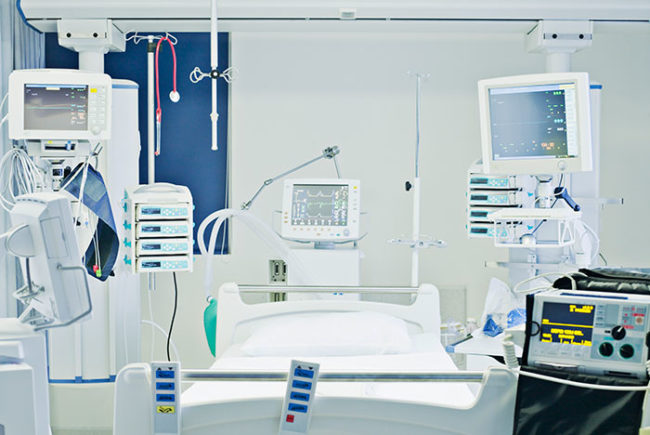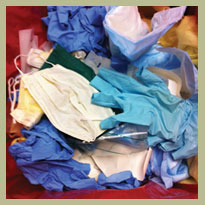 Arkansas Children's Hospital (ACH) in Little Rock is among the nation's largest pediatric medical centers serving more than 14,000 inpatients every year. After a $121 million expansion, the campus now spans over 29 city blocks and employs 4,500 full-time team members.
Arkansas Children's Hospital (ACH) in Little Rock is among the nation's largest pediatric medical centers serving more than 14,000 inpatients every year. After a $121 million expansion, the campus now spans over 29 city blocks and employs 4,500 full-time team members.
Its size and patient volume inevitably mean that resulting waste streams across many departments are equally impressive in size — including highly regulated medical waste.
Six steps
The hospital recommends that other hospitals take the following six steps to make their operations more sustainable based on ACH's experience.
1. Align the vision with management. The first step for Arkansas Children's Hospital Environmental Management Coordinator Joe Knight and his team was aligning management's vision to a sustainability program. ACH wanted to ensure that multiple waste streams were not only managed safely for staff, patients and visitors but that they were also long lasting, compliant and cost-effective. This was to be the hospital's first sustainability program, and Knight knew that first impressions were critical.
"There are different shades of green when it comes to the sustainability efforts of hospitals. I have become a realistic environmentalist. When I first started this role, I acknowledged that we are in the business of helping children get well and not in the business of saving the planet. Now we recognize we can do both at the same time," noted Knight.
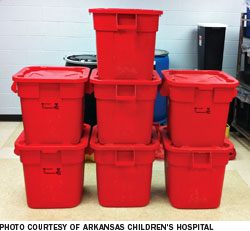 |
|---|
| During random audits, baseline data collected from samples revealed that 84 percent of waste being disposed in red bags in these containers was not regulated medical waste. |
2. Know where to throw hospital waste. Given that 80 percent of waste streams are highly regulated, a second step is to identify waste streams and with a dedicated team, often called a "green team," develop policies and conduct training for proper segregation to put waste where it belongs and to separate hazardous waste from other waste.
Consider where teams place waste and how to appropriately segregate it. Many hospitals can throw as much as 20 to 25 percent of waste into the biohazardous red bags, although a large portion of it is non-regulated such as paper, cardboard and food waste. Not knowing exactly what percentage ACH's red bag, regulated medical waste (RMW) represented in total waste, an ACH task force was assigned to this critical area for a year.
During random audits, baseline data collected from samples revealed that a whopping 84 percent of waste being disposed in red bag containers was not RMW and staff had, in fact, not known where to throw it.
These results caught the team and hospital leadership's attention as the baseline was only 16 percent actual red bag waste when correctly managed. This type of practice increases disposal costs by a factor of 10 times or more according to Practice Greenhealth. "RMW segregation practices were implemented in 20 departments and after 6 months, RMW was dramatically reduced," says Knight.
These successes were acknowledged when ACH's "Know Where to Throw" program won the Children's Hospital Association 2012 Race for Results Red Bag Waste Reduction out of 44 entries.
"Our sustainability program is in its infancy. Only three years old, our ‘Know Where to Throw' trash campaign is really working," says Knight. "We are having an environmental impact by making the right choices," Knight concludes. His original safety role expanded into a larger initiative for ACH that now encompasses sustainability as a priority.
3. Understand state-by-state regulations and legislation. A third step is understanding regulations and legislation, which vary by state. For instance, know the rules and performance standards by the Environmental Protection Agency (EPA) for air emissions. Evidence suggests as much as 15 to 25 percent of all medical waste is treated by incineration when only 2 to 3 percent of medical waste must be incinerated due to regulatory requirements. By law prescription, trace chemo and pathological waste must be incinerated in certain states.
"The state of Arkansas requires that hospitals incinerate certain types of RMW," says Knight.
There is a need for hospitals to better segregate RMW to reduce incineration percentages to between 2 to 5 percent of total waste. Some hospitals and systems still have 40 to 50 percent incineration rates, which is too high. With the new standards, emissions reductions are expected to be achieved.
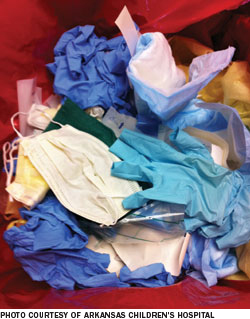 |
|---|
| Hospital items such as gloves, gowns, paper and plastic packaging were discovered in a red bag, although they do not meet the definition of regulated medical waste and should not have been thrown in there. |
4. Take a reusable approach. Once streams are identified and appropriately segregated for disposal, step four for hospitals to consider is managing each stream the most efficiently, keeping compliance and the environment in mind.
"We chose a partner to guide us on all steps including converting to and proactively exchanged reusable sharps containers," says Knight. "Our pharmaceutical waste compliance program also uses reusable containers. So we are keeping drugs out of the water supply and plastic out of landfills with these services."
For every one reusable container, 600 disposable containers are kept from the landfill. When Arkansas Children's Hospital implemented a sharps management service using reusable sharps containers, it annually prevented nearly 20,000 pounds of carbon dioxide emissions by not putting 32,351 pounds of plastic and 2,475 pounds of cardboard in the landfill. The hospital's accomplishment is equivalent to not burning 988 gallons of gas.
With the goal of safe water, the hospital wanted to make a pharmaceutical waste compliance service a priority for helping to keep drugs out of the public water supply. A service also keeps hospitals in compliance with the regulations and legislation driven by the EPAs Resource Conservation and Recovery Act defined hazardous waste requirements. "Protecting the environment is not just a regulatory requirement, it is the right thing to do," says David Berry, senior vice president and chief operating officer. With a very large formulary of over 5,500 medications, ACH was the first hospital in Arkansas to have a fully comprehensive waste compliance program.
Since service inception in 2010, the hospital has managed over 35 tons of pharmaceutical waste that is characterized as 30 tons of nonhazardous waste and 5.5 tons of hazardous pharmaceutical waste. From 2011 to 2012 the hospitals total tons of pharmaceutical waste decreased from 19 tons to 13 tons, signaling quite an improvement led by nursing, environmental services and safety.
5. Recycle your way toward greater sustainability. In addition to the above steps for achieving sustainability, hospitals can take a fifth step by not looking at waste as waste. Items such as desks, chairs, water pitchers, cups, laptops and iPads are recyclable. ACH significantly increased its recycling focus to continue greening its operations and has set a goal of achieving a 15 percent recycling rate of total waste in 2014.
"Arkansas Children's Hospital started with some fledgling ideas and under the guidance of environmental management," says Richard James, environmental health and safety officer. "Once these five steps were determined, then our goals were raised to include reusable sharps containers, pharmaceutical waste compliance service, battery recycling and consumable (i.e., cardboard, aluminum and plastic container) recycling. Taking these steps allowed us to determine the next layer of our vision for where the organization wanted to be in five years."
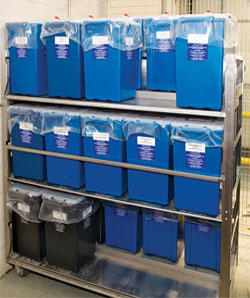 |
|---|
| Pharmaceutical containers are part of the hospital's pharmaceutical waste compliance service. |
6. Share the lessons learned. A sixth step for making a sustainability program more sustainable is recognizing that a continuous process improvement cycle was necessary and that it could stand the test of time. By establishing teams, collecting data, communicating progress, educating staff, celebrating milestones and building upon success, ACH's vision is being realized. The plan that ACH developed produced measurable results that started to accumulate.
Knight involved from the beginning senior administrators such as its COO sponsor, front-line environmental services workers and clinical staff including nurses and physicians from various departments. Other departments including education, infection prevention, process improvement and nursing education made the program a reality as it was implemented allowing personnel in 20 departments to know where to throw.
ACH won two awards from Practice Greenhealth — the"Partner Recognition" in 2009 and the "Partner for Change" in 2011. Mark Wietecha, president and CEO of the Children's Hospital Association, cited ACH's award-winning efforts as "one example of how we strive for excellence every day" as the hospital reduced costs in RMW, resulting in a 94 percent reduction of waste … and more than $20,000 in the pediatric intensive care unit alone, and a hospitalwide reduction of waste by 32 percent. These efforts equate to $118,000 in savings annually," says Wietecha.
Creating cultural change
When these six steps for achieving a sustainability program are taken, stakeholders stay very engaged and the program can stand the test of time. This six-step approach to change is influential for creating a sustainable culture. "The program is now built into the fabric of how the hospital operates. Our sustainability commitment is firmly entrenched into the day-to-day mindset of taking care of our patients and our environment," concludes Knight.
Debra Gillmeister is vice president, healthcare services, at Stericycle Inc., Lake Forest, Ill. She can be reached at dgillmeister@stericycle.com.





